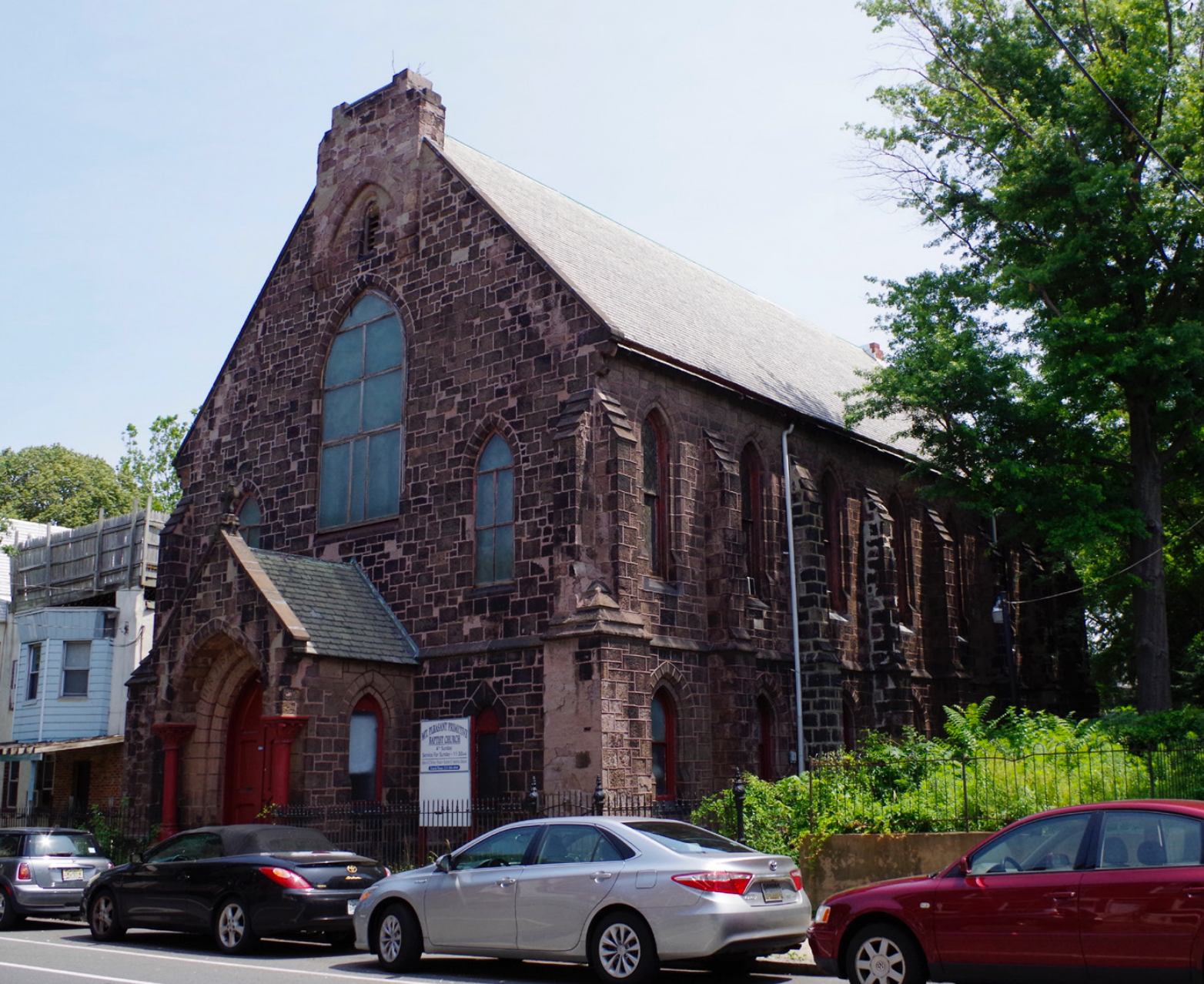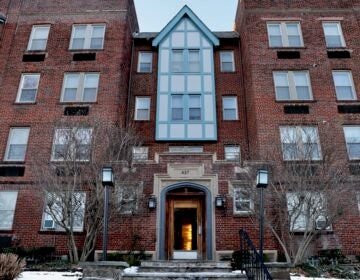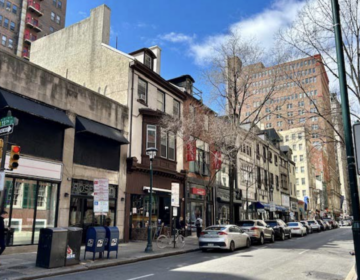Handful of West Philly properties designated historic, including wee district

Friday’s meeting of the Historical Commission opened with the latest twist in the ongoing St. Laurentius saga, but otherwise the meeting proceeded in a fairly breezy fashion. Which is not to say that nothing of note occurred—it saw the designation of the first historic district in six years—but the business that did take place proceeded at a remarkably rapid clip, with five cases being added to the local register of historic places over the course of a half hour. In fact, every single case up before the commission was added to the local register of historic places with the exception of a couple technicalities at the end of the session.
3827-33 Powelton Avenue, Pennsylvania Industrial Home for Blind Women
The brevity can be explained by the lack of opposition to the proceedings. Some properties such as the Pennsylvania Industrial Home for Blind Women at 3827-33 Powelton Avenue were supported in-person by the owners of the building themselves. (The commission’s own staff wrote the nomination and the commission quickly voted to approve their case even before St. Laurentius came up.)
435-41 N 38th Street, Christ Methodist Episcopal Church, Mt. Pleasant Primitive Baptist
The Historical Commission described themselves as “very impressed” with the nomination for this church, which towers mid-block in the Mantua neighborhood of West Philadelphia.
“The site is on the middle of the block which is an unusual location for a church,” said Bob Thomas, the architect who chairs the commission. “But I looked at some old atlases and if you look at the north side of the 37th block of Hamilton street there are six houses there that are much later than all the other houses on Powelton. And the church property used to extend to Hamilton so obviously, they got into a tight spot at some point and sold off their greenspace.”
Amy Lambert, who prepared the nomination on behalf of the University City Historical Society, confirmed his analysis. Built in 1870, the building in question was only meant to be the chapel of the Christ Methodist Episcopal Church. The property it sits on used to be more expansive, and a far larger church would have been erected adjacent to the current building. But the church fell on hard times and was forced to sell off property.
420-34 S 42nd Street, the 420 Row Historic District
Next up, the first new historic district to be approved since 2010. Ironically, the 420 Row is within the boundaries of the previously proposed Spruce Hill Historic District. But its ambitions are far more narrow in scope, covering only a single row of eight, three-story stately red brick Queen Anne-style houses.
Located on the west side of 42nd Street between Osage and Baltimore Avenues, nominator Justin McDaniel says that they represent the first Queen Anne-style speculative development in Spruce Hill.
At last month’s designation committee meeting, the members were only too happy to support the nomination, praising the merits of these buildings and how little they’d been altered over time.
“We ‘d like to state for the record that this is the first new historic district approved by the commission in a while and we think it is a great thing,” said Paul Steinke, head of the Preservation Alliance for Greater Philadelphia. “We are excited that we will be adding a 16th local historic district.”
10751 and 10725 Knight’s Road, Byberry Township Public Burial Ground
The long-running saga around the Byberry Township Burial Ground came to an end at this Historical Commission meeting. First nominated over ten years ago, but turned down for technical reasons, the cause of the old cemetery was taken up by Joseph J. Menkevich in recent years.
“You have the first adventurers buried in that ground, the people who came over with William Penn,” said Menkevich. “It never really had any repair work done, it just got forgotten during consolidation of the city [in 1854]. I’d just like to see it designated.”
At the December designation hearing, the previous nominator stirred up some controversy by suggesting that Menkevich got the precise parcels of the site wrong in his nomination. But the Historical Commission staff did some additional research and found that his nomination was sound and could proceed.
The efforts of Menkevich and his compatriots have attracted the ire of neighbors who have apparently edged their properties into the space.
“We have witnessed encroachments by surrounding properties on this place,” said John Charles Manton, but there hasn’t been a survey of property lines. “When you go on the property you get signs saying no trespassing, people come out with bats and threaten you. They say you are harassing them, photographing their children, that you are pedophiles.”
Chairman Thomas said he encountered similar neighborly sentiments when doing trail work and greenway implementation in the past. A commission decision to designate would be just the thing to reassert city care of its property he said, and so it did.
22-26 S 40th Street, West Philadelphia Institute
When the West Philadelphia Institute stood before the designation committee last month, chair Emily Cooperman, voted against recommending its addition to the local register. The old lecture hall, constructed in 1876, had been shrouded in a rather ugly cladding that she felt represented too dramatic of an alteration from the original. Cooperman voted against recommending it while her colleagues dissented.
At January’s larger commission hearing Patrick Grossi of the Preservation Alliance explained that his organization believed while there are significant architects associate with the building, they also nominated it for reasons of social historical significance. Additionally, the new equitable owner supported the nomination so there wasn’t any other opposition to the nomination.
The commission was persuaded on the point and voted unanimously to add it to the local register.
5250 Wayne Avenue, Methodist Episcopal Church of the Advocate
This century-old church in Germantown is in a tricky legal space at the moment, which is why preservation activists nominated it now.
“It’s actually in a weird limbo land because the congregation hasn’t been active in 20 to 30 years,” said Sue Patterson, one of the nominators and head of the Penn Knox Neighborhood Association. “Some neighbors have spoken to workmen coming in and out and they are looking for an heir to the pastor on the deed, so we are very concerned. That’s why we are making a move to preserve what we’ve got because we don’t know what’s coming.”
The Circus School expressed interest in the building, but it had been deemed structurally dangerous and was considered too big a risk. It later came out that it was only the parapet of the bell tower that was unsafe.
Convinced, the commission added it to the register.
4054 Chestnut Street, rescission request
At the last meeting of the designation committee, zoning lawyer Michael Sklaroff presented a case to un-designate the house at 4054 Chestnut Street. Only added to the register last summer, the house recently saw several of its neighbors demolished before the committee could add them to the register. (In that case, the demolition permits were obtained before the preservation gears could get into motion.) Now the owner of 4054 Chestnut wants his property taken off the register as well, although Sklaroff insists that no comparable destruction is planned.
“This building in its own right is no longer fundamentally significant,” said Sklaroff. “There are no pending permits for alteration of demolition. The land owner believes, however, that the property should be free of regulation and should not be on the register because it is not of that level and is not significant.”
At the designation committee’s meeting, Sklaroff argued that the building had been altered to such an extent that it could no longer be deemed historically relevant. The front stoop had been removed, along with the original windows and the dormer on top. The committee didn’t find the case at all credible and voted uniformly against it.
Undeterred by last month’s rejection, Sklaroff presented the same case to the larger commission. But they too were unconvinced, and voted uniformly to deny the recession request.
“I’m leery of establishing a precedent of rescinding a nomination that has been added so recently and has precedent with the neighboring properties,” said Antonio Fiol-Silva, in opposition. “When the other two were demolished the building put in there was of such savage quality that it really demeaned the whole block.”
Much of the drama from the hour long battle over the case resulted from the question of whether the commission could rule on the case at all. Zoning lawyer Hal Shirmer noted that the owner had already appealed the decision to the court of common pleas. That should divest the municipality of jurisdiction over the case, he said, because the exact same case is currently in front of a judge in City Hall. Allowing a board to amend its decision after an appeal has been taken could lead to piece meal litigation and piecemeal appeals.
But Andrew Ross, of the city’s law department, personally stopped by to assure the commission that they had the power to make a decision on the matter.
4046 and 4048 Chestnut Street
As an addendum to the day’s action, and the previous case, the nominations of neighboring properties that had been tabled on the same August day were brought up again. These buildings had been demolished and so the nominations were brought up again so they could be voted down, as there are no more buildings to save.
WHYY is your source for fact-based, in-depth journalism and information. As a nonprofit organization, we rely on financial support from readers like you. Please give today.







